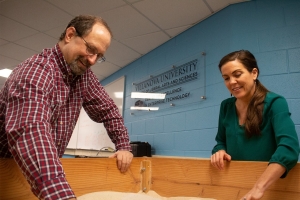Villanova Receives Interdisciplinary National Science Foundation Grant to Implement Augmented Reality Sandboxes

No matter how old you get, there’s something fun about playing in a sandbox. Thanks to a grant from the National Science Foundation (NSF), a group of interdisciplinary researchers from Villanova University’s College of Liberal Arts and Sciences and College of Engineering will be developing high-tech sandboxes to provide hands-on learning for students. Villanova Center of Excellence in Enterprise Technology (CEET) Director and professor of Computing Sciences Frank Klassner, PhD, was awarded a three-year, $300,000 NSF grant for the project, titled “Enhancing the Augmented Reality Sandbox's Software and Hardware to Support Quantitative Simulation for STEM Education.” Villanova faculty members Lisa Marco-Bujosa, PhD, assistant professor of Education, Kabindra Shakya, PhD, assistant professor of Geography and the Environment, and Virginia Smith, PhD, assistant professor of Civil Engineering are helping oversee and bring this technology to labs on campus.
The technology is based around projecting a colorful augmented reality display onto sand in a real sandbox, and it was created by a researcher at University of California, Davis in 2012. The box was originally used in public exhibits for science education but has since been adopted by universities and research centers around the world. It allows users to evaluate hydrological processes through the shifting of the sand. The height of the piles of sand within the box equate to different elevations of land masses. Virtual water can then be added to show how it flows within the changing landscapes.
“There are a lot of learning situations where students benefit from seeing the scenario from different perspectives,” Klassner said. “These technologies help students make instantaneous relations, which helps them learn the overall discipline much more comprehensively."
Augmented Reality Sandbox with Real-Time Water Flow Simulation - UC Davis
The grant aims to raise the capability of the technology, which currently doesn’t account for scale and doesn’t allow for information about the simulated soil such as permeability to be added into the sandbox. Klassner says the goal is to allow students to quantitatively model these scenarios. Shakya says information can help provide real-world examples for his students.
“We can sample what a map would look like for 25. 50, 100 and 500-year floods and see how the different scenarios play out,” Shakya said. “We just had a rare flood in Philadelphia, but what does it mean? Now we can actually see it.”
In addition to conveying environmental impacts, the box can help engineering students.
“In civil engineering we often think about how infrastructure and the environment interact,” Smith said. “The additions to the sandbox will provide the ability to better illustrate how changes to a landscape can impact engineering design.”
Klassner says the team hopes to install four or five boxes across labs on campus and hopes the upgraded software could eventually be licensed and used by other institutions. For now, the work being done within the colleges at Villanova will help shape the landscape of the sandbox’s future.
“It’s in CEET’s blood to bring faculty together from different departments and different disciplines to do innovative and creative work,” he said. “We’re a large enough school that we have a variety of faculty with talent in diverse areas, but we’re a small enough school that when we want to do a big project, all we have to do is walk across campus.”
